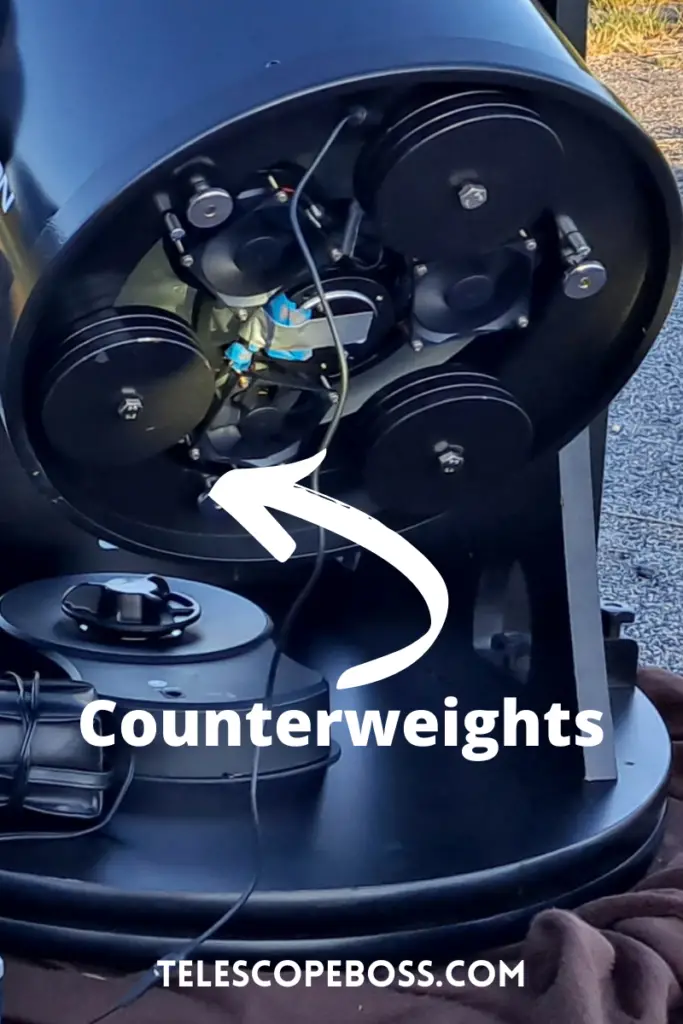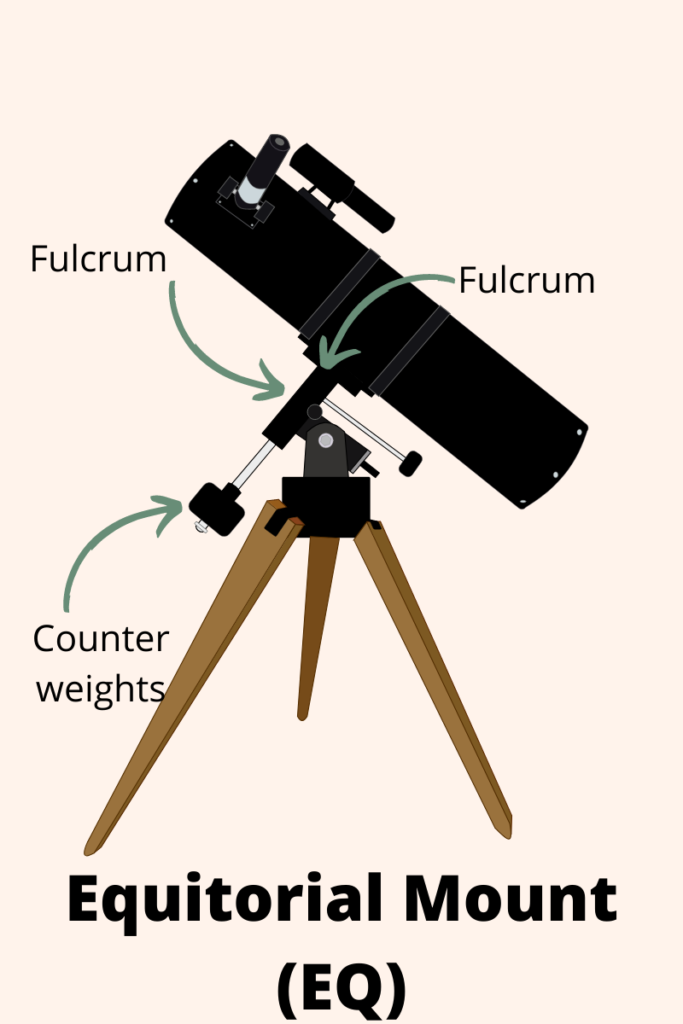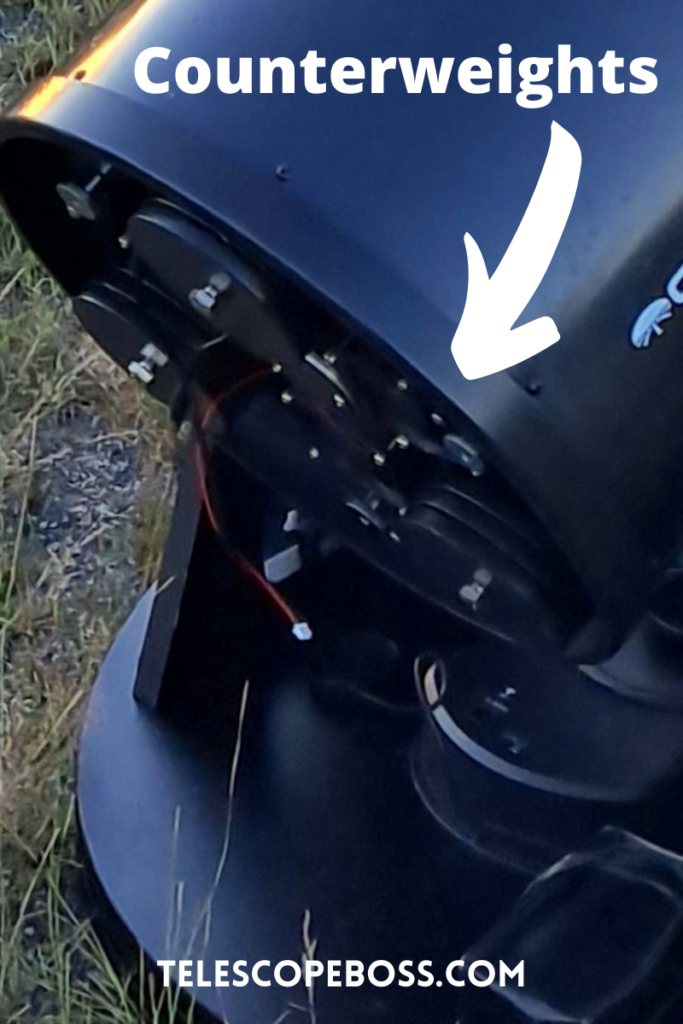Telescope counterweights are used to make tracking objects smooth and allow them to move more easily.
Counterweights are most often used on equatorial mounted telescopes, but they can also be helpful on alt-az mounted telescopes. Counterweights are used to balance the weight of the telescope like a see saw. When the weight is close to equal on both sides of the fulcrum, the scope will move easily. Motorized tracking telescopes should be balanced as well as possible to avoid unnecessary strain on the motors.
Balance is even more important for astrophotography so that the movement of the scope is smooth. If you need to manually balance the scope the footage will be shaky.
My Dobsonian mounted telescope has counterweights on the bottom of the optical tube behind the primary mirror. Every time I set up my scope I have to balance the scope by adding or removing weight.
These weights are enough for most of my eyepieces, but if I use heavy eyepieces or cameras I may need to add weight so it can remain balanced.
EQ mounts must be balanced each time they are set up as well.
Always be careful when installing or changing the weights. Tighten all screws when moving the scope. My weights screw onto the back of my scope and they can easily grab and pinch cords or my fingers. I have seen pictures of toes crushed by telescope weights, and I heard a story of someone needing dental work after dropping a weight on their face. Double check all weights before attempting to move the scope so you dont surprise yourself.
When slewing your scope or tracking for photography if a weight falls your scope will jump, ruining your image and potentially damaging your telescope.

What can be used as a counterweight?
Telescope weights are expensive and it can be difficult to get exactly what you need. There are lots of DIY options for counterweights:
- Ankle weights
- Magnets
- Sandbags with Velcro
- Dumbbell Plates
- Sand in a Water Bottle
- Sections of Steel Pipe
- Magnetic Bag Weight
- Lead Wheel Weights
There are a lot of methods for creating DIY telescope counterweights and the best method will depend on your scope.
DIY Counterweights for EQ Mounts

EQ mounts carry their weight on a dovetail, a bar that sticks out opposite of the telescope. Weight there should be about equal to the weight of the telescope.
When you add equipment like dew heaters, finderscopes, cameras, or guidescopes the weight will need to be adjusted.
In a pinch a water bottle filled with sand and taped to the dovetail will allow you to keep observing until you find a more permanent solution.
Water in the bottle will likely not be heavy enough and you will need to use sand.
This solution can be used as your permanent counterweight if you like it, I would recommend a metal water bottle for durability. It could be attached to the dovetail with adhesive or brackets.
Ankle weights would be a neater solution that could easily velcro around the dovetail.
Traditional weight plates for weightlifting can be attached to a dovetail as well, but be so careful because they can easily slip off your dovetail. Use small weights and double check that they are secure before you move your scope.
This is my favorite video demonstrating how to balance your EQ mounted telescope:
DIY Counterweights for Alt-Az and Dobsonian Mounts

The easiest way to attach weights to a larger tube telescope is with magnets.
These magnets from Harbor Freight can simply be attached to your optical tube, or you can sew them into a cloth bag to avoid scratching the surface of your OTA. They are a little more than a half a pound and a bit more than $5. This can be used to incrementally increase the weight and balance the telescope.
Sew the magnet into a bag or put a barrier between the magnet and the telescope, you could use a washcloth.
Another method I have seen uses ziplocks full of sand and then sew them into a long tube of fabric and wrap it around the optical tube and attach with velcro. This is a popular method for creating a more permanent solution. It protects the tube and is easy and affordable.
The chipping paint on my weights is also a danger to my equipment, so even if you have counterweights, it may be wise to cover them in cloth to keep them from damaging your equipment.

Why do we balance telescopes?
Telescopes need to be balanced so that they can move easily.
Unbalanced telescopes can move up and down wildly causing damage to your scope. Telescopes are delicate instruments and you want to be able to control the movement.
A balanced telescope will not move when you take your hand off of the scope, this is important because if you may not notice that the scope is unbalanced when you are observing close to the zenith, but when you move to observe something close to the horizon and you take your hand off the scope it could drop to the ground causing damage.
Motorized telescopes require balance to move smoothly. The motors will wear out if the scope is unbalanced because it requires more force to move an unbalanced scope.
A balanced telescope is safer.
Can a telescope be used without a counterweight?
Visual observing is possible with an unbalanced telescope. Balance makes it easier to move your telescope and makes it easier for the motors to move your telescope.
If you do not have your telescope counterweights you can still use your telescope, but you should keep your hand on the scope so you can keep it from falling.
Not all telescopes require counterweights. Smaller alt-az mounted telescopes may not require any counterweights at all.
You can determine if your telescope needs counterweights by finding a target close to the horizon and taking your hand off the scope. Does the scope move? If it moves then you need counterweights.





